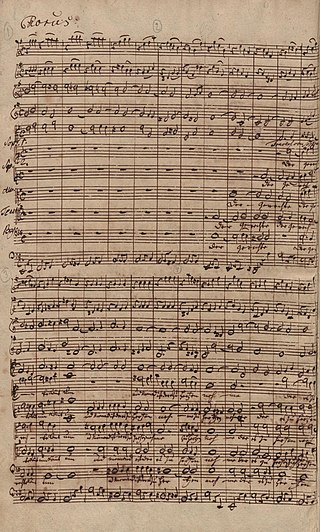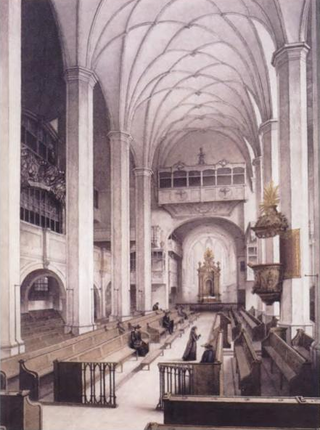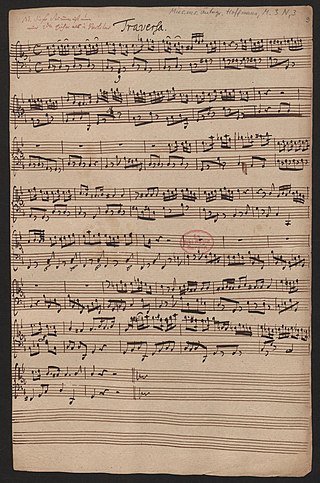Related Research Articles

Johann Ludwig Bach was a German composer and violinist.
Throughout his life as a musician, Johann Sebastian Bach composed cantatas for both secular and sacred use. His church cantatas are cantatas which he composed for use in the Lutheran church, mainly intended for the occasions of the liturgical year.
Johann Christoph Altnickol, or Altnikol, was a German organist, bass singer, and composer. He was a student, copyist and son-in-law of Johann Sebastian Bach.

Johann Sebastian Bach composed the church cantata Wer Dank opfert, der preiset mich, BWV 17 in Leipzig for the fourteenth Sunday after Trinity and first performed it on 22 September 1726.
Most of Johann Sebastian Bach's extant church music in Latin—settings of the Mass ordinary and of the Magnificat canticle—dates from his Leipzig period (1723–50). Bach started to assimilate and expand compositions on a Latin text by other composers before his tenure as Thomaskantor in Leipzig, and he continued to do so after he had taken up that post. The text of some of these examples by other composers was a mixture of German and Latin: also Bach contributed a few works employing both languages in the same composition, for example his early Kyrie "Christe, du Lamm Gottes".
As Thomaskantor, Johann Sebastian Bach provided Passion music for Good Friday services in Leipzig. The extant St Matthew Passion and St John Passion are Passion oratorios composed by Bach.
Vereinigte Zwietracht der wechselnden Saiten, BWV 207.1, is a secular cantata composed by Johann Sebastian Bach and first performed on 11 December 1726 in Leipzig.
"Nun lob, mein Seel, den Herren" is a Lutheran hymn written in German by the theologian and reformer Johann Gramann in 1525. It was published in 1540 and appears in 47 hymnals. A translation by Catherine Winkworth, "My Soul, now Praise thy Maker!", was published in 1863.

Wer ist der, so von Edom kömmt is a pasticcio Passion oratorio based on compositions by Carl Heinrich Graun, Georg Philipp Telemann, Johann Sebastian Bach and others. The pasticcio was assembled around 1750.
The Telemann-Werke-Verzeichnis, abbreviated TWV, is the numbering system identifying compositions by Georg Philipp Telemann, published by musicologist Martin Ruhnke.
The Dietel manuscript, D-LEb Peters Ms. R 18, also known as the Dietel Collection and, in German, Choralsammlung Dietel, is the oldest extant manuscript with a large collection of four-part chorales by Johann Sebastian Bach. It contains 149 of Bach's chorale harmonisations and originated around 1735. The music in the manuscript was copied by Johann Ludwig Dietel, one of Bach's pupils from the Thomasschule.

Sei Lob und Preis mit Ehren, BWV 28/2a and BWV 231, identical to the second movement of BWV Anh. 160, is a motet composed by Johann Sebastian Bach. It was composed some time in 1725.

The Magnificat in A minor, BWV Anh. 21, TWV 1:1748, is Melchior Hoffmann's musical setting of a German version of the Song of Mary from the Gospel of Luke. The composition originated around 1707, when the composer was director musices and organist of the Neue Kirche in Leipzig. Composed in A minor, the Magnificat is scored for soprano and small orchestra. The work was first published in the 1950s, and it was recorded by Magda László, by Joshua Rifkin, by Wolfgang Helbich, and by Deborah York, among others.
Sing(e)t dem Herr(e)n ein neues Lied is German for "sing unto the Lord a new song". The German expression may refer to:

There are four church cantatas by Georg Philipp Telemann sharing the title Singet dem Herrn ein neues Lied:

Der Gerechte kömmt um, BWV 1149, is a motet for SSATB singers and instrumental ensemble, which, for its music, is based on the five-part a cappella motet Tristis est anima mea attributed to Johann Kuhnau, and has the Luther Bible translation of Isaiah 57:1–2 as text. The arrangement of the Latin motet, that is, transposing it to E minor, adjusting its music to the new text, and expanding it with an instrumental score for two traversos, two oboes, strings and basso continuo, is attributed to Johann Sebastian Bach. The setting is found in a manuscript copy, likely written down in the 1750s, of Wer ist der, so von Edom kömmt, a Passion oratorio which is a pasticcio based on compositions by, among others, Carl Heinrich Graun, Georg Philipp Telemann and Bach. Likely Der Gerechte kömmt um existed as a stand-alone motet, for example for performance on Good Friday or at a funeral, before being adopted in the pasticcio.
References
- 1 2 3 Melamed, Daniel R. (1995). J. S. Bach and the German Motet. Cambridge University Press. pp. 89–97. ISBN 0-52-141864-X.
- 1 2 3 4 5 "Work 1471". Bach Digital . Leipzig: Bach Archive; et al. 2019-03-11.
- 1 2 Instrumental and Supplement bach333.com
- 1 2 "D-B Mus. ms. Bach P 37, Fascicle 1". Bach Digital . Leipzig: Bach Archive; et al. 2020-01-15.
- ↑ Peter Wollny, Tennstedt, Leipzig, Naumburg, Halle – Neuerkenntnisse zur Bach-Überlieferung in Mitteldeutschland, Bach-Jahrbuch 2002, pp. 36–47.
- ↑ David Schulenberg (2010).The Music of Wilhelm Friedemann Bach. University of Rochester Press.[ page needed ]
- ↑ "D-DS Mus. ms. 1325". Bach Digital . Leipzig: Bach Archive; et al. 2020-01-19.
- ↑ Philipp Spitta. Johann Sebastian Bach. Leipzig: Breitkopf & Härtel, third print (1921). Vol. I, endnote 24 pp. 800–801 and Vol. II, pp. 428–429
- ↑ "Work 36". Bach Digital . Leipzig: Bach Archive; et al. 2020-02-07.